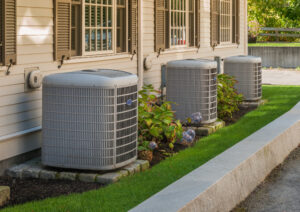Main Types of HVAC Systems

By selecting the right HVAC system, you can create a comfortable and productive environment while optimizing energy usage and reducing costs. Let’s explore the most common types of HVAC systems, their unique advantages, and how they cater to different building types and climates.
Ducted HVAC Systems
Ducted HVAC systems utilize a network of ducts to distribute conditioned air throughout a building. These systems are commonly found in larger structures and offer excellent overall climate control.
Split Systems
Split systems consist of an outdoor unit (condenser) and an indoor unit (evaporator) connected by refrigerant lines. They use ductwork to distribute conditioned air.
Advantages:
- Energy Efficiency: Split systems often feature high Seasonal Energy Efficiency Ratio (SEER) ratings, leading to energy savings.
- Flexibility: Suitable for both small and large spaces, split systems offer the ability to cool or heat multiple rooms.
- Quiet Operation: The condenser unit is located outside, reducing noise levels inside the building.
Suitability: Split systems are ideal for residential homes, small offices, and single-zone commercial spaces.
Hybrid Split Systems
Hybrid split systems combine a traditional gas furnace with an electric heat pump. They switch between gas and electric heating to optimize energy usage.
Advantages:
- Energy Savings: The hybrid functionality allows for more cost-effective heating options based on outdoor temperatures.
- Versatility: Hybrid systems provide both heating and cooling capabilities, making them suitable for year-round use.
- Reduced Carbon Footprint: By utilizing electricity and gas as fuel sources, these systems promote energy efficiency and lower emissions.
Suitability: Hybrid split systems are a good fit for regions with moderate climates and buildings with access to both gas and electricity.
Packaged Heating and Cooling
In packaged systems, all components, including the compressor, condenser, and evaporator, are housed in a single unit typically placed on the roof or in a mechanical room.
Advantages:
- Space Efficiency: Packaged systems are suitable for buildings with limited space since they don’t require an indoor unit.
- Easy Installation: These systems are pre-assembled and tested, reducing installation time and costs.
- Minimal Noise: The system’s location outside the building minimizes indoor noise levels.
Suitability: Packaged systems are commonly used in commercial buildings, retail spaces, and apartments where rooftop installation is feasible.
Zoned Systems
Zoned systems divide a building into separate zones, allowing for customized temperature control in each area.
Advantages:
- Energy Efficiency: Zoning enables targeted heating and cooling, reducing energy waste in unoccupied or less frequently used zones.
- Personalized Comfort: Occupants can adjust the temperature independently within their designated zones.
- Cost Savings: Zoned systems help lower utility bills by optimizing energy consumption.
Suitability: Zoned systems are particularly effective for large buildings, multi-story homes, or spaces with varying occupancy levels.
Ductless HVAC Systems
Ductless HVAC systems, also known as mini-splits, provide localized heating and cooling without the need for ductwork. They offer flexibility and efficiency, making them a popular choice in many applications.
Duct-Free Mini-Split
Duct-free mini-split systems consist of an outdoor unit connected to one or more indoor units. The indoor units are typically mounted on walls or ceilings and are responsible for delivering conditioned air directly into the space.
Advantages:
- Easy Installation: Duct-free mini-split systems are relatively simple to install since they require only a small hole to connect the indoor and outdoor units.
- Flexibility: Each indoor unit operates independently, allowing for personalized temperature control in different zones or rooms.
- Energy Efficiency: By eliminating ductwork, duct-free mini-splits minimize energy loss and improve efficiency.
Suitability: Duct-free mini-split systems are suitable for residential homes, small offices, apartments, and buildings where adding ductwork is impractical or costly.
Hydronic Heating
Hydronic heating systems use water to distribute heat. They consist of a boiler or heat pump that heats water, which is then circulated through pipes or tubing installed in floors, walls, or radiators.
Advantages:
- Comfortable Heat: Hydronic systems provide radiant heat, creating a cozy and consistent warmth throughout the space.
- Energy Efficiency: Water has excellent heat retention properties, allowing hydronic systems to operate efficiently.
- Zoning Capabilities: By controlling the flow of hot water, different zones can be created for customized temperature control.
Suitability: Hydronic heating systems are suitable for residential and commercial buildings, particularly those seeking a comfortable and energy-efficient heating solution.
Portable Spot Coolers
Description: Portable spot coolers are compact, self-contained units designed to provide targeted cooling in specific areas or for temporary cooling needs.
Advantages:
- Mobility: Portable spot coolers can be easily moved and positioned where cooling is required.
- Quick Installation: These units do not require complex installation or ductwork.
- Cost-Effective: Spot coolers offer a cost-effective solution for cooling small spaces or providing temporary relief during hot weather conditions.
Suitability: Portable spot coolers are commonly used in server rooms, offices, event spaces, and temporary structures where immediate cooling is needed.
Portable Heat Pumps
Portable heat pumps are versatile units that provide both heating and cooling functionality. They can be moved from room to room as needed.
Advantages:
- Portability: Portable heat pumps offer flexibility, allowing users to heat or cool specific areas without the need for permanent installation.
- Energy Efficiency: These units are designed to provide efficient heating and cooling, contributing to energy savings.
- Cost Savings: By focusing on heating or cooling specific areas, portable heat pumps can help reduce overall energy consumption.
Suitability: Portable heat pumps are suitable for residential spaces, offices, small commercial settings, or temporary structures where temporary and versatile heating and cooling are required.
HVAC System Components
Familiarizing yourself with the different parts of an HVAC system can help with troubleshooting and potentially save money on repairs. Here’s an overview of the six key components of an HVAC system and their importance.
Heat Exchanger
Heat exchanger is a crucial component that facilitates the transfer of heat between two fluids (air, water, or refrigerants) without them mixing together. The primary function of a heat exchanger in an HVAC system is to either heat or cool the air being circulated throughout the building or space, depending on the desired temperature.
The three most commonly used types of heat exchangers in HVAC systems are finned coils, tube bundles (including flooded), and plate heat exchangers.
Thermostat
The thermostat is the control center of your HVAC system, with temperature sensors that help regulate when to heat or cool your home. A malfunctioning thermostat is a common HVAC issue, which could be resolved by replacing batteries or cleaning the thermostat. In larger homes with multiple floors, thermostats in different zones report back to the main unit for more precise temperature control.
Blower Motor
The blower motor powers the fan that circulates air through the ductwork and into different rooms. If your blower motor needs repair or replacement, you may experience loud noises, screeching, or reduced airflow.
Combustion Chambers
In a gas-powered HVAC system, the combustion chamber is where the fuel burns to generate heat. The heat from the combustion process feeds into the heat exchanger, which then heats your home. According to the U.S. Department of Energy, natural gas is used in more than 50% of U.S. homes for HVAC systems.
Condenser Unit
The condenser unit is a key component of an air conditioning system, responsible for transferring hot air outside your home by compressing refrigerant and expelling heat through the condenser coils. Regular maintenance, such as keeping the condenser unit and coils clean and free of debris, is crucial for optimal performance and efficiency.
Clogged or obstructed condenser units can lead to increased energy bills and reduced cooling efficiency.
Ductwork
Ductwork is the network of channels that distribute air throughout your home. Made from materials such as sheet metal or synthetic materials, ducts need to be clean for optimal performance.
Regular vent cleaning can prolong the life of your HVAC system, while clogged ductwork can increase allergens in the air and decrease system performance.
FAQ
How frequently should I swap the air filters in my HVAC system?
It’s generally advisable to swap air filters every 1 to 3 months, depending on filter type and pollutant levels in your indoor surroundings. Regular filter changes enhance airflow, boost indoor air quality, and relieve strain on the HVAC system.
What are the benefits of regular HVAC maintenance?
A: Regular HVAC maintenance ensures peak performance, energy efficiency, and an extended lifespan. It also aids in detecting and addressing potential issues before they snowball into major problems, enhances indoor air quality, and diminishes the risk of unexpected breakdowns.
Why does my HVAC system emit peculiar odors?
Peculiar odors from an HVAC system can stem from various factors, including mold or mildew growth, grimy air filters, clogged condensate drain lines, or even critters trapped in the ductwork. Identifying and promptly resolving the source of the odor is crucial to avoid further complications.
What are the common reasons behind HVAC system breakdowns?
HVAC system breakdowns often occur due to neglected maintenance, electrical component failures, refrigerant leaks, frozen coils, thermostat issues, or blocked airflow caused by dirty filters or obstructed ducts. Regular maintenance and timely repairs minimize breakdowns.
How can I enhance the energy efficiency of my HVAC system?
To boost energy efficiency, focus on proper insulation, sealing air leaks in the building envelope, utilizing programmable thermostats to optimize temperature settings, maintaining clean filters, and considering an upgrade to energy-efficient HVAC equipment boasting high SEER (Seasonal Energy Efficiency Ratio) ratings.
Final Thoughts
By selecting the right HVAC system and properly maintaining it, you can create a comfortable environment while minimizing energy usage and reducing costs.
Remember to change air filters, schedule regular HVAC maintenance, address peculiar odors promptly, and take steps to enhance energy efficiency, such as proper insulation and sealing air leaks.
Check Out Additional HVAC Resources
- Things to Consider Before Replacing Your HVAC Unit
- 7 Signs to Call an HVAC Technicians
- HVAC Terms Homeowners Need to Know
- HVAC System Maintenance Checklist
- Guide to Furnace Flame Sensors

Anna has over six years of experience in the home services and journalism industries and serves as the Content Manager at MyHomePros.com, specializing in making complex home improvement topics like HVAC, roofing, and plumbing accessible to all. With a bachelor’s degree in journalism from Auburn University, she excels in crafting localized, comprehensive guides that cater to homeowners’ unique needs. Living on both coasts of the United States has equipped her with a distinctive perspective, fueling her passion for turning any house into a cherished home through informed, personalized decision-making.
Connect with top-rated local contractors who can help you with siding, roofing, HVAC, windows, and more. Get free quotes from verified professionals in your area today.








